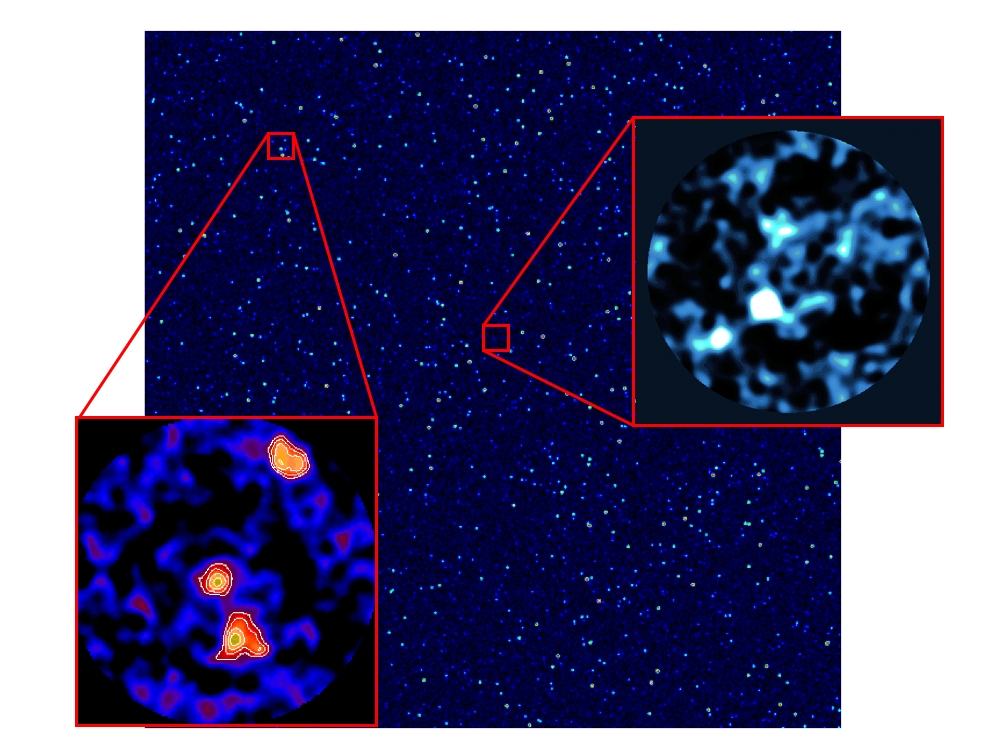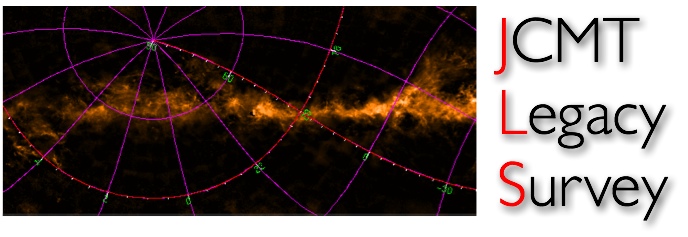SCUBA-2 Cosmology Legacy Survey
The SCUBA2 Cosmology Legacy Survey (S2CLS) is a collaboration of ~100 scientists across the three partner countries who run the James Clerk Maxwell Telescope (JCMT): Canada, the UK and the Netherlands (with a few individuals based in other countries). The survey will exploit the immense increase in mapping speed, fidelity and sensitivity of the new SCUBA2 submillimeter camera on the JCMT. The goal of the survey is to provide the first large samples of extragalactic sources selected in the 450- and 850-µm wavebands. These atmospheric windows allow us to access the redshifted far-infrared emission from luminous but highly, high-redshift galaxies and AGN – pin-pointing an intense era of activity in the early Universe associated with the formation of massive galaxies and black holes. The survey has a simple two-tier design, comprising a wide 850-um component and a deeper 450-µm survey over a smaller region. The target regions are located in a set of well-defined fields with appropriately low far-infrared backgrounds, and the extensive multi-frequency supporting data necessary for our analysis. This single co-ordinated survey programme will revolutionize our understanding of submillimetre galaxies, and indeed galaxy formation in general, with enormous and lasting legacy value, as well as providing a springboard for future exploitation of Atacama Millimeter Array (ALMA), Herschel, LOFAR, James Webb Space Telescope (JWST) and the Square Kilometer Array (SKA). The survey design has two elements: 1) a 0.7-mJy rms 850-µm survey of around 35 square degrees, sufficient to map either the accessible SWIRE Spitzer survey regions or other similar-sized regions with comparable supporting data; 2) a deeper survey undertaken in the best conditions to obtain 450-µm coverage to 0.5-mJy rms of 1.3 square degrees in the GOODS fields, UKIDSS UDS and COSMOS regions.The 850-µm target sensitivity of 0.7mJy will deliver a map in which the noise contributions from the thermal background and extragalactic source confusion noise are comparable. This depth is also sufficient to provide strong (>10-sigma) detections of the ~5,000 bright sources with fluxes >8mJy, essential to i) keep false detections at <1%, ii) provide positions accurate to ~2 arcseconds, thus minimizing false identifications. These observations will also deliver a large number of significant detections at the 3-5 mJy level, allowing the first detailed statistical study of this less-extreme component of the submillimetre galaxy population around the flux limit where the 850-µm counts exhibit a break in their slope. At the same time they will have the area coverage needed to search for rare sub-classes of submillimetre galaxies (e.g. transition objects) which may provide powerful insights into the processes operating within these systems, such as starburst- and AGN-powered feedback, and trace overdensities of submillimetre sources which may pin-point the initial collapse of proto-clusters.
The survey design has two elements: 1) a 0.7-mJy rms 850-µm survey of around 35 square degrees, sufficient to map either the accessible SWIRE Spitzer survey regions or other similar-sized regions with comparable supporting data; 2) a deeper survey undertaken in the best conditions to obtain 450-µm coverage to 0.5-mJy rms of 1.3 square degrees in the GOODS fields, UKIDSS UDS and COSMOS regions.The 850-µm target sensitivity of 0.7mJy will deliver a map in which the noise contributions from the thermal background and extragalactic source confusion noise are comparable. This depth is also sufficient to provide strong (>10-sigma) detections of the ~5,000 bright sources with fluxes >8mJy, essential to i) keep false detections at <1%, ii) provide positions accurate to ~2 arcseconds, thus minimizing false identifications. These observations will also deliver a large number of significant detections at the 3-5 mJy level, allowing the first detailed statistical study of this less-extreme component of the submillimetre galaxy population around the flux limit where the 850-µm counts exhibit a break in their slope. At the same time they will have the area coverage needed to search for rare sub-classes of submillimetre galaxies (e.g. transition objects) which may provide powerful insights into the processes operating within these systems, such as starburst- and AGN-powered feedback, and trace overdensities of submillimetre sources which may pin-point the initial collapse of proto-clusters.
The main driver for the area of the 850-µm survey is the need to deliver a sample of sufficient size to reliably measure the clustering of the submillimetre population (to constrain galaxy formation models) and to detect and study the (rare) progenitors of rich clusters. Both of these goals require survey areas of 10’s of square degrees. An upper limit to the realistic area of such a survey is provided by the areal coverage of the Spitzer SWIRE fields (see below), which provide the essential supporting multi-wavelength data needed for source identifications, etc. The area of the SWIRE fields accessible from Mauna Kea is approximately 35 square degrees – the goal of the S2CLS is to cover a comparable area. The allocation of time for this aspect of the survey in the first two years of SCUBA2 survey operations, totaling 630 hours in weather bands 2-3 (300 hours in band 2 and 330 hours in band 3) is sufficient to map 15 square degrees down to our adopted sensitivity limit. There is also a recommended allocation of a further 900 hours over the following three years to extend the survey to ~30 square degrees, although this allocation is provisional and subject to competition from new or existing surveys.
For the deep 450-µm survey, the depth is set by the goal of obtaining the first confusion- limited imaging at 450-µm (expected to correspond to an rms noise of 0.5mJy). This will enable us to resolve for the first time the bulk of the extragalactic background light at 450-µm, as well as providing precise positions sufficient to directly identify the counterparts to these sources in other wavebands and assess the size of the submillimetre-emitting regions. In parallel with these observations we will also obtain extremely deep 850-µm observations of these regions which will provide both high-quality submillimetre colours for the 450-µm sources and information about the very faint 850-µm population, although these will be highly confused. The atmospheric opacity means that these observations are only sensibly undertaken in the best conditions and hence the maximum achievable area for the 450-µm survey is primarily set by the likely availability of suitable weather conditions. Nevertheless, the availability of complementary deep, multi-wavelength datasets provides a natural upper limit of ~2 square degrees from the combined area of GOODS-N/S, COSMOS and UKIDSS UDS fields. The 450-µm tier of the CLS was the highest ranked element of the entire SCUBA2 legacy programme and so nearly all (almost 90%) of the available Band 1 weather in the first two years of SCUBA2 survey operations was awarded to this survey, totalling 490 hours, which should be sufficient to cover 0.5 square degrees at the required depth. There is also a recommended allocation of a further 630 hours of band 1 weather in the following three years, to extend the 450-micron survey to a final area of 1.3 square degrees, although again this is subject to competition from new or existing surveys.
The Cosmology Legacy Survey will yield samples of 10,000’s of extragalactic sources with robust detections at 450-µm or 850-µm over scales spanning ~30-200 Mpc, sufficient to provide fair samples. The survey will produce the first reliable measurements of the angular clustering of the 850-µm galaxy population, as well as resolving the population responsible for the 450-µm extragalactic background. The results and follow-up of the sources from this survey will provide powerful insights into the properties of obscured activity across the history of the Universe. In the longer term, the survey will demonstrate its legacy value through future investigations with ALMA, Herschel and JWST.
The 2-year programme
The revised list of survey fields is given below along with the planned area coverage (within 2yrs for the 850-µm areas) and the maximum viable area which could be covered.Fields revised as of March 2013.
| 450-µm Survey Fields | RA (hr) | Max. area (sq. deg) | ALMA accessible? |
|---|---|---|---|
| COSMOS | 10 | <0.25 | Y |
| GOODS-N | 12 | 0.05 | N |
| E-CDFS | 03 | <0.25 | Y |
| UKIDSS/UDS | 02 | <0.25 | Y |
| 850-µm Survey Fields | RA (hr) | 2yr Area (sq. deg) | Max. area (sq. deg) |
|---|---|---|---|
| Lockman | 10 | 0.5 | 11 |
| COSMOS | 10 | 2 | 2 |
| EGS | 14 | 1 | 1 |
| SSA22 | 22 | 1 | 6 |
| UKIDSS/UDS | 02 | 1 | Y |
| GOODS-N | 12 | 0.5 | N |




